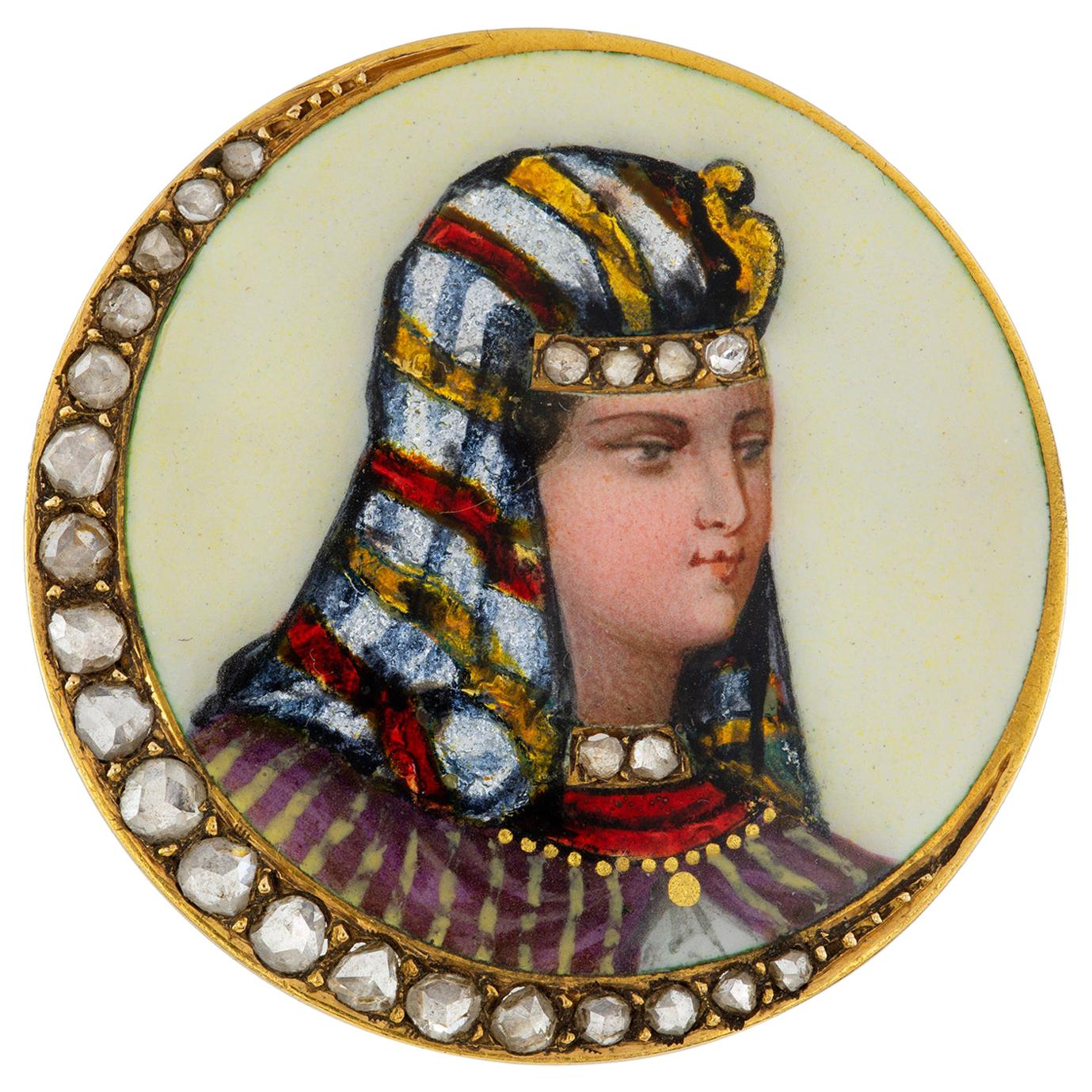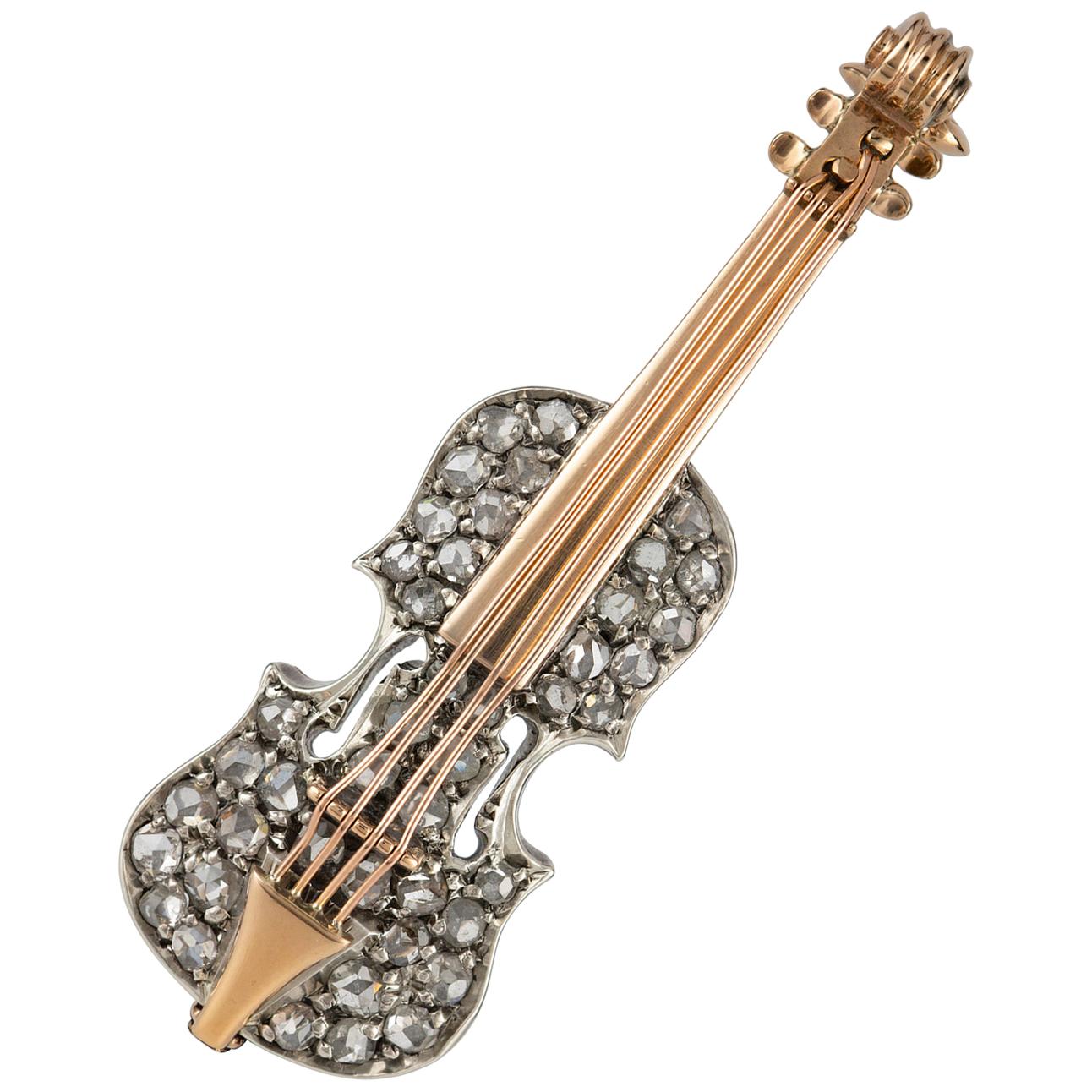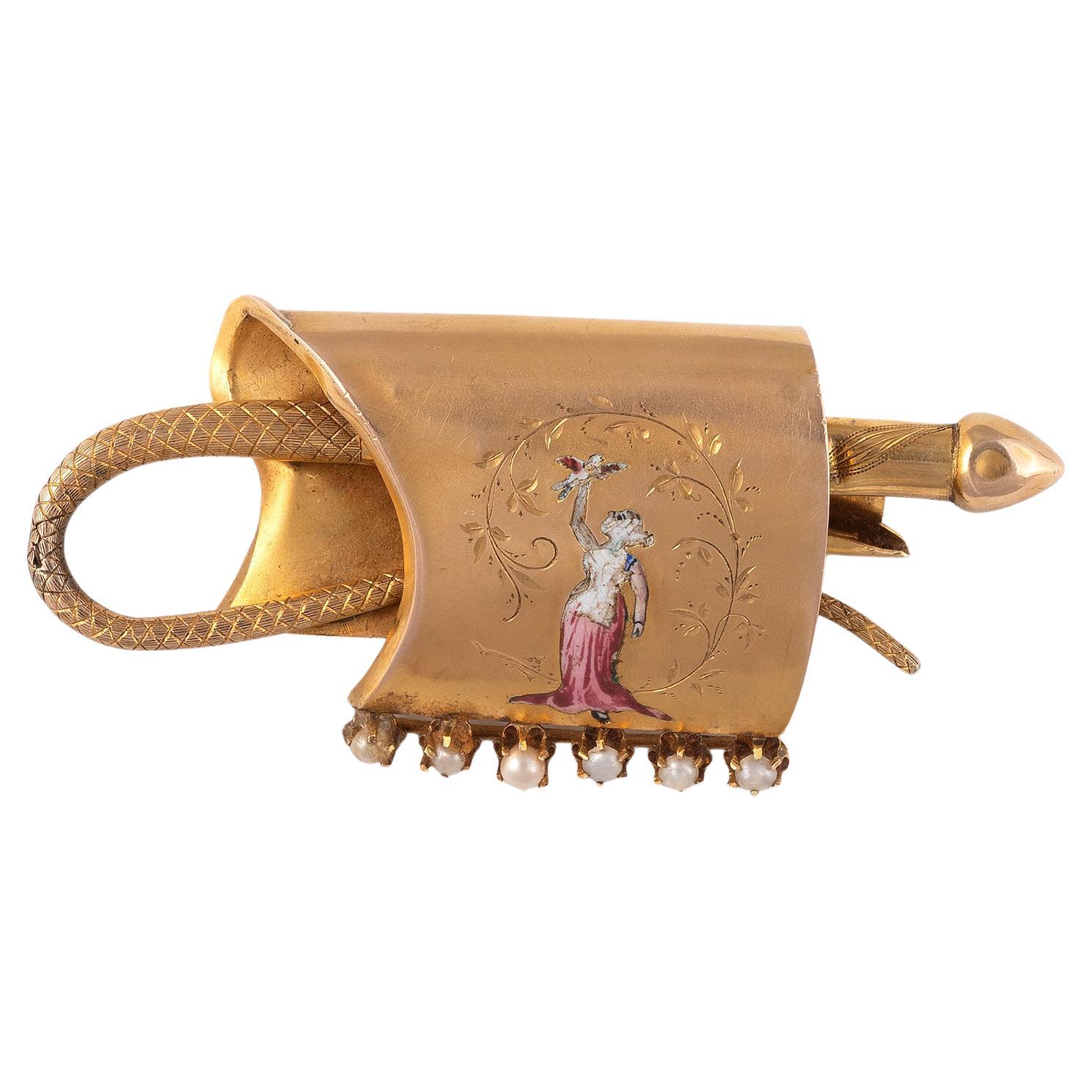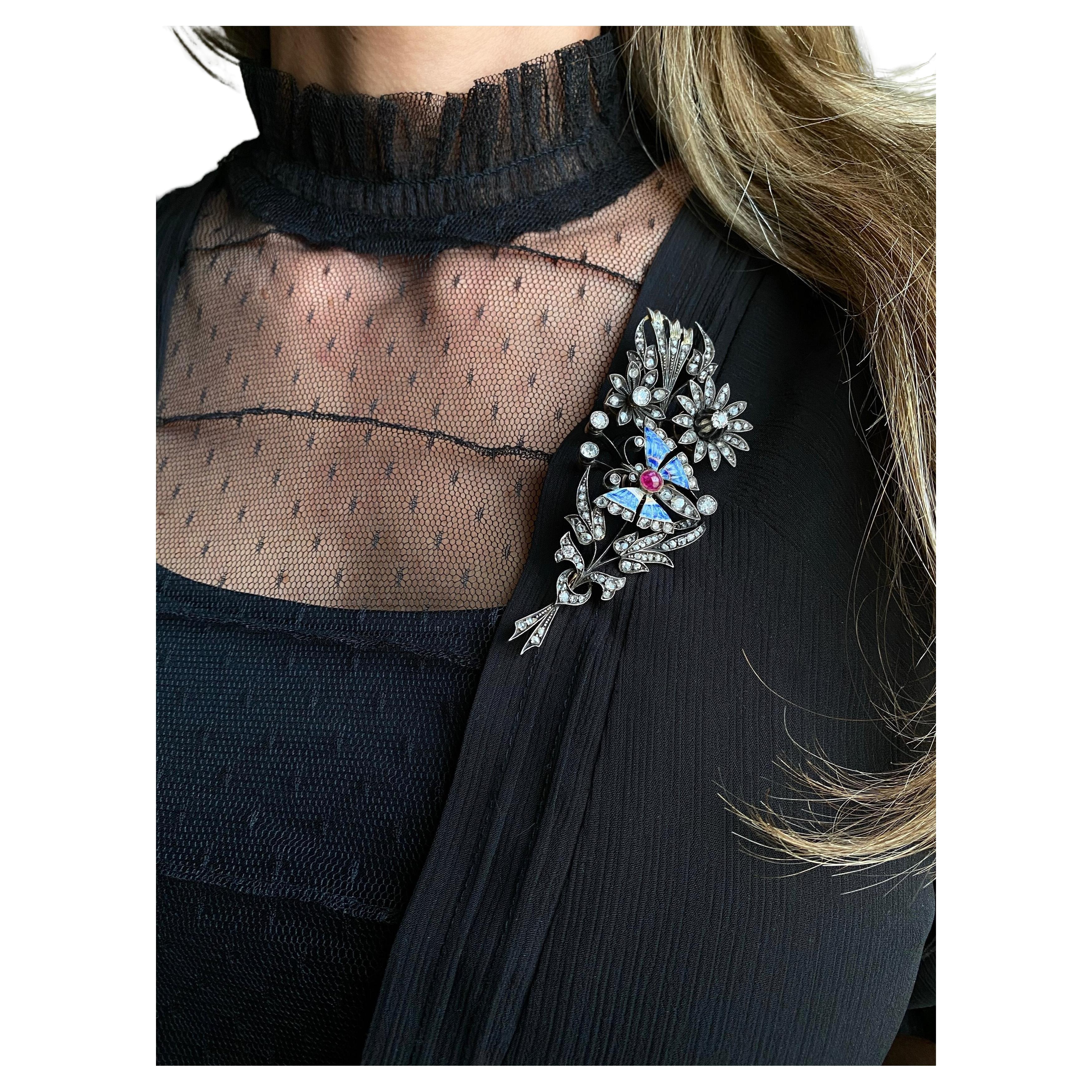Items Similar to Late 19th-Century Enameled Brooch with Diamonds by Falize
Video Loading
Want more images or videos?
Request additional images or videos from the seller
1 of 6
Late 19th-Century Enameled Brooch with Diamonds by Falize
About the Item
Alexis Falize
Brooch with depiction of Renaissance Lady
France (Paris), c. after 1894
Gold, silver, enamel, diamonds
Weight 10.7 gr.; Width 43.6 mm.; Height 22.3 mm.
Gold rectangular brooch with enameled decoration. In the central medallion with gold beaded border against a black background the profile bust of a Renaissance lady dressed in translucent red with green, gold edging embellished with pearls and in matching colors a headdress and white veil. The side panels are decorated with symmetrical scroll ornaments in gold, translucent green, and red enamel against an ivory-colored background. Along the rim of the brooch are clusters and single diamonds set in silver. On the brooch pin is the maker’s mark Alexis Falize, along with the French mark of the eagle’s head and the numbers ‘416’ (unexplained).
It comes as no surprise that Lucien Falize and his firm, fascinated by the art of enameling, teamed up with other artists specialized in painted Limoges-style enamels to produce brooches, pendants, watches, and bracelets adorned with circular plaques. This brooch, combining Falize’s cloisonné enamel with a Renaissance-inspired portrait of an aristocratic lady, is a particularly lovely example.
Falize was one of the first jewelers to incorporate independent translucent painted enamels into his jewels, employing freelance artists including Alfred Meyer, Charles LePec, Claudius Popelin, Paul Grandhomme, and Alfred Garnier. One of the most spectacular examples from the firm is the so-called Gaston Phebus necklace commissioned by the Prince de Béarn-Viana and completed in 1887. Alfred Meyer signed these portraits on the counter-enamel. Falize praises the work of Charles LePec for his use of gold plaque, instead of copper, as a background because it “animates the reds and enriches all the tones.” He used Claudius Popelin for smaller pieces including a necklace of Diana. Working for Falize at least from 1876 to 1891, Paul Grandhomme, with whom he became friends, also painted over paillons and supplied a ground for his figures of opaque blue, black, or brown enamel, as appears on our brooch. Lacking a signature, the present enamel portrait could be by one of Grandhomme’s assistants or followers.
Sixteenth-century engravings, such as by Virgil Solis (1514–c. 1562), with scrollwork and moresque ornaments on frieze decorations and inserted round medallions with historical figures, inspired the overall design of the brooch. Unusual is the three-dimensional application of the red enamel cloisons of the foliage on this brooch, which gives the appearance of gemstones, and the addition of diamonds demarcating the frame.
- Creator:
- Metal:Gold,Silver,Enamel,18k Gold
- Stone:Diamond
- Stone Cut:Rose Cut
- Weight:10.7 g
- Dimensions:Height: 0.88 in (22.3 mm)Width: 1.72 in (43.6 mm)
- Style:Renaissance Revival
- Place of Origin:France
- Period:1890-1899
- Date of Manufacture:after 1894
- Condition:Wear consistent with age and use.
- Seller Location:Chicago, IL
- Reference Number:
About the Seller
5.0
Vetted Seller
These experienced sellers undergo a comprehensive evaluation by our team of in-house experts.
Established in 1991
1stDibs seller since 2021
5 sales on 1stDibs
Typical response time: 13 hours
- ShippingRetrieving quote...Ships From: Chicago, IL
- Return PolicyA return for this item may be initiated within 3 days of delivery.
More From This SellerView All
- Late 19th-Century Silver and Opal Cape Clasp by Louis WièseLocated in Chicago, ILLouis Wièse Cape Clasp France (Paris), c. 1890 Silver, opals Weight 102.8 gr.; Length 22.23 cm.; individual clasp diameter(s) c. 44 mm. Two openwork roundels in relief show a Chinese dragon head in cast and chased silver, entwined by a serpentine body with bird’s feet and talons. The eyes are formed of opal cabochons. Both roundels are joined by a wire loop and hook as clasp and eight chain links of twisted wire with intersecting plain loops. Traces of gilt remain. On the reverse along the edge of both roundels is the maker’s mark “WIESE” for Louis Wièse. This beguiling cloak clasp...Category
Antique 1890s French Gothic Revival Brooches
MaterialsOpal, Silver
- Gothic Revival Gold Ring with Joan of Arc by Louis Wièse, Late 19th CenturyLocated in Chicago, ILJoan of Arc Ring by Louis Wièse (1852-1930) France, c. 1890 Gold Weight 9.3 gr.; Circumference 56.45 mm.; US size 7 3/4; UK size P ½ Cast and chased openwork gold ring with square section hoop, grooved on the lower half and forked at the shoulder to form a triangular frame for a Gothic trefoil...Category
Antique 1890s French Gothic Revival Cocktail Rings
MaterialsGold
- 19th century Water Squirt Ring in Silver and Gold with Rock CrystalLocated in Chicago, ILSquirt Ring West European, 1800-1900 Silver, gold, rock crystal Weight 9.4 gr.; circumference 60.38 mm.; cylinder length 41.2 mm US size 9 ¼ ; UK size S ¼ Fascinating nineteenth century party piece, incorporating an elegant and sparkling ring Description: Squirt ring made of a hollow silver cylinder with four ornamental bands and a cap with plunger. This holds the liquid, and when the plunger is pulled out and pushed back in the squirt mechanism is triggered. At the other end is a hollow ring through which the liquid flows and then squirts out of a small hole on the band next to the gemstone. The gold ring, angled to the cylinder, has a tubular hoop and a gold round-shaped cup bezel with a silver-set, facetted rock crystal gemstone. The ring is fully functionable. The cylinder lies concealed in the palm of the hand. Punched on the cylinder is a swan, the French guarantee mark for the fineness of silver on items of unknown origin (in use from 1893-1970). Along the gold hoop of the ring are four indistinct hallmarks: a helmeted head (?), two rectangular punch marks, one with lower case ‘g’ in the corner, and traces of two illegible punches. Provenance: Yves Brasseur (26 February—11 August 2005), Ghent, Belgium, a collector of rings who was a Belgian fencer of Olympic stature, having competed in this sport in the Olympics in the 1960s. Literature: The earliest account of a squirt ring dates to about 1770 with the description of a diplomatic incident at the Court of Frederick the Great. The French ambassador M. de Guines belonged to the diplomatic corps in Berlin, the capital of the Prussian Empire. His pompous behavior was widely mocked. Prince Dolgorouki, the Russian ambassador was invited to a gala dinner as a guest of honor with his newly wed bride. She was seated next to the French ambassador whom she squirted with water from a mechanism concealed in the palm of her hand, when he was admiring her jewel. He vowed he would throw a glass of water at her if she continued. The ambassador’s wife ignored his warning, and he in fact put his threat into effect. The guests at the dinner were obliged to keep a discreet silence surrounding this embarrassing occurrence. The fashion for such squirt rings appears to have continued into the nineteenth century, although few examples are known. The designs and materials vary: bronze ring with mask of Silenus in the Victoria and Albert Museum. Silenus, the god of wine-making and drunkenness, appears again on a squirt ring in form of a garnet cameo...Category
Antique 19th Century European Solitaire Rings
MaterialsRock Crystal, Quartz, Gold, Silver
- Renaissance Portrait Cameo of Emperor Vespasian in a Gold BroochLocated in Chicago, ILPortrait Cameo of Emperor Vespasian in a Gold Brooch Agate, gold Italy?, 16th century Weight 10.2 gr.; Dimensions 48.7 × 39 mm. Description: Three-layered agate cameo (black-white-...Category
Antique 16th Century Italian Brooches
MaterialsAgate, Gold
- Enameled Heart-Shaped Pendant with Cherub & Seed Pearls by Carlo Giuliano c.1880By Carlo GiulianoLocated in Chicago, ILCarlo Giuliano HEART-SHAPED PENDANT WITH CHERUB England (London), c. 1880 Gold, enamel, seed pearls Weight 8.6 gr.; Height 33.3 (42.1 with loop) mm; Width 30.8 mm; Of all the Reviv...Category
Antique 1880s English Revival Pendant Necklaces
MaterialsPearl, Gold, Enamel
- Renaissance Reliquary Pendant with Pearl and EnamelingLocated in Chicago, ILRELIQUARY PENDANT WITH PEARL Spain or Spanish Netherlands, c. 1620 Gold, rock crystal, enamel, pearl, bone relics Weight 12.9 grams; dimensions 40 ...Category
Antique 1620s Spanish Renaissance Pendant Necklaces
MaterialsPearl, Gold, Enamel
You May Also Like
- Late 19th Century French Enamel and Diamond BroochLocated in London, GBA late 19th century French enamel and diamond brooch, the centre depicting an enamelled Egyptian Queen with rose-cut diamond-set headdress decorations, within a rose diamond-set crescent, all mounted in yellow gold with a pierced gallery, bearing French gold marks for 18ct gold, Paris 1847-1919, makers mark P.B. , circa 1880, measuring approximately 2.8cm in diameter, gross weight 5.4grams. This antique brooch is in good condition, minimal enamel defiant. An exquisite late-nineteenth century Egyptian revival enamel and diamond brooch from the collection of Bentley & Skinner, the London jewellers by appointment to both Her Majesty the Queen and His Royal Highness the Prince of Wales. After Napoleon’s Egyptian...Category
Antique 1880s French Egyptian Revival Brooches
MaterialsDiamond, Enamel, 18k Gold
- Late 19th Century Diamond BroochLocated in London, GBA late nineteenth century diamond brooch, finely modelled in the form of a violin, the body encrusted with rose-cut diamonds and the strings, neck and head in rose gold, French Impor...Category
Antique 1890s French Late Victorian Brooches
MaterialsDiamond, 14k Gold, 9k Gold, Rose Gold, Silver
- Lyra Diamonds Brooch, Late 19th CenturyLocated in Sežana, SILyra-shaped brooch – Made in Italy – Late 19th century. The brooch is set with 25 rose cut natural diamonds. The main body is made of gold, while the upper part and settings are in...Category
Antique Late 19th Century Italian Classical Roman Brooches
MaterialsDiamond, Gold, Silver
- Late 19th Century Enamel, Half Pearl and Gold BroochLocated in Firenze, ITThe central plaque decorated with a polychrome enamel female deity gazing the dove on the pearl paviment. Under the scene we can find a snake. Width 4.5cmCategory
Antique 1870s Italian Victorian Brooches
MaterialsPearl, Gold, Enamel
- Late 19th C Enamel, Ruby and Diamond Set En Tremblant Flower BroochLocated in Hummelstown, PAA delightful ‘en Tremblant’ brooch, c1890. Exceptionally hand-fabricated in silver topped gold, this piece centers on a freeform spray of flowers, lined in shimmering rose cut and ol...Category
Antique 1890s Brooches
MaterialsDiamond, 14k Gold, Silver, Enamel
- Late 19th Century Fly BroochLocated in London, GBA late 19th century fly brooch, the bee set with a dementoid garnet, a ruby eye, diamond wings and a pearl body, set in silver and gold, with a further pear...Category
Antique 19th Century Unknown Late Victorian Brooches
MaterialsAmazonite, Diamond, Garnet, Ruby, Yellow Gold, Silver
Recently Viewed
View AllMore Ways To Browse
Gr Watch
White Gold Lady Watch
18k Diamond Lady Watch
18k Gold Diamond Lady Watch
Ladys Diamond Set Watch
18k Our Lady
19th Century Copper Panels
Gold And Black Ladys Watch
Ivory Necklace
18k Diamond Set Watch Ladys
Small Lady Watch
Antique Pendant Watch Necklace
Antique Watch Pendant Necklaces
Pearl Cluster Necklace
Eagle Watch
Gold Beaded White Dress
Charles Garnier
Bead Cluster Necklace





